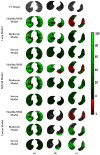The Role of 3D CT Imaging in the Accurate Diagnosis of Lung Function in Coronavirus Patients
- PMID: 35328249
- PMCID: PMC8947065
- DOI: 10.3390/diagnostics12030696
The Role of 3D CT Imaging in the Accurate Diagnosis of Lung Function in Coronavirus Patients
Abstract
Early grading of coronavirus disease 2019 (COVID-19), as well as ventilator support machines, are prime ways to help the world fight this virus and reduce the mortality rate. To reduce the burden on physicians, we developed an automatic Computer-Aided Diagnostic (CAD) system to grade COVID-19 from Computed Tomography (CT) images. This system segments the lung region from chest CT scans using an unsupervised approach based on an appearance model, followed by 3D rotation invariant Markov-Gibbs Random Field (MGRF)-based morphological constraints. This system analyzes the segmented lung and generates precise, analytical imaging markers by estimating the MGRF-based analytical potentials. Three Gibbs energy markers were extracted from each CT scan by tuning the MGRF parameters on each lesion separately. The latter were healthy/mild, moderate, and severe lesions. To represent these markers more reliably, a Cumulative Distribution Function (CDF) was generated, then statistical markers were extracted from it, namely, 10th through 90th CDF percentiles with 10% increments. Subsequently, the three extracted markers were combined together and fed into a backpropagation neural network to make the diagnosis. The developed system was assessed on 76 COVID-19-infected patients using two metrics, namely, accuracy and Kappa. In this paper, the proposed system was trained and tested by three approaches. In the first approach, the MGRF model was trained and tested on the lungs. This approach achieved 95.83% accuracy and 93.39% kappa. In the second approach, we trained the MGRF model on the lesions and tested it on the lungs. This approach achieved 91.67% accuracy and 86.67% kappa. Finally, we trained and tested the MGRF model on lesions. It achieved 100% accuracy and 100% kappa. The results reported in this paper show the ability of the developed system to accurately grade COVID-19 lesions compared to other machine learning classifiers, such as k-Nearest Neighbor (KNN), decision tree, naïve Bayes, and random forest.
Keywords: COVID-19; Computer Assisted Diagnosis (CAD); Markov–Gibbs Random Field (MGRF); SARS-CoV-2; machine learning; neural network.
Conflict of interest statement
The authors declare no conflict of interest.
Figures







Similar articles
-
Early assessment of lung function in coronavirus patients using invariant markers from chest X-rays images.Sci Rep. 2021 Jun 8;11(1):12095. doi: 10.1038/s41598-021-91305-0. Sci Rep. 2021. PMID: 34103587 Free PMC article.
-
Precise higher-order reflectivity and morphology models for early diagnosis of diabetic retinopathy using OCT images.Sci Rep. 2021 Feb 25;11(1):4730. doi: 10.1038/s41598-021-83735-7. Sci Rep. 2021. PMID: 33633139 Free PMC article.
-
Precise Segmentation of COVID-19 Infected Lung from CT Images Based on Adaptive First-Order Appearance Model with Morphological/Anatomical Constraints.Sensors (Basel). 2021 Aug 14;21(16):5482. doi: 10.3390/s21165482. Sensors (Basel). 2021. PMID: 34450923 Free PMC article.
-
A Novel Computer-Aided Diagnostic System for Early Detection of Diabetic Retinopathy Using 3D-OCT Higher-Order Spatial Appearance Model.Diagnostics (Basel). 2022 Feb 11;12(2):461. doi: 10.3390/diagnostics12020461. Diagnostics (Basel). 2022. PMID: 35204552 Free PMC article.
-
Development and integration of VGG and dense transfer-learning systems supported with diverse lung images for discovery of the Coronavirus identity.Inform Med Unlocked. 2022;32:101004. doi: 10.1016/j.imu.2022.101004. Epub 2022 Jul 8. Inform Med Unlocked. 2022. PMID: 35822170 Free PMC article. Review.
Cited by
-
Multimodal Diagnostics of Changes in Rat Lungs after Vaping.Diagnostics (Basel). 2023 Oct 30;13(21):3340. doi: 10.3390/diagnostics13213340. Diagnostics (Basel). 2023. PMID: 37958237 Free PMC article.
-
Impact of Imaging Biomarkers and AI on Breast Cancer Management: A Brief Review.Cancers (Basel). 2023 Oct 30;15(21):5216. doi: 10.3390/cancers15215216. Cancers (Basel). 2023. PMID: 37958390 Free PMC article. Review.
-
How AI Can Help in the Diagnostic Dilemma of Pulmonary Nodules.Cancers (Basel). 2022 Apr 6;14(7):1840. doi: 10.3390/cancers14071840. Cancers (Basel). 2022. PMID: 35406614 Free PMC article.
-
An AI-based novel system for predicting respiratory support in COVID-19 patients through CT imaging analysis.Sci Rep. 2024 Jan 8;14(1):851. doi: 10.1038/s41598-023-51053-9. Sci Rep. 2024. PMID: 38191606 Free PMC article.
References
-
- World Health Organization . Transmission of SARS-CoV-2: Implications for Infection Prevention Precautions: Scientific Brief, 09 July 2020. World Health Organization; Geneva, Switzerland: 2020. Technical Report.
-
- COVID-19 Pandemic Planning Scenarios. [(accessed on 30 December 2021)];2021 Available online: https://www.cdc.gov/coronavirus/2019-ncov/hcp/planning-scenarios.html.
-
- Coronavirus Cases. 2021. [(accessed on 3 January 2022)]. Available online: https://www.worldometers.info/coronavirus/
LinkOut - more resources
Full Text Sources
Miscellaneous

